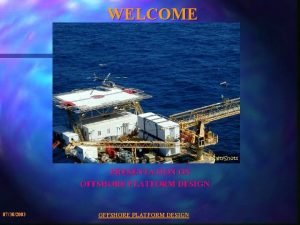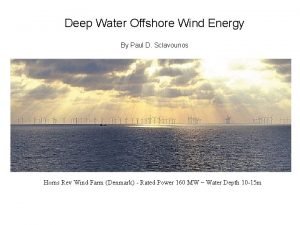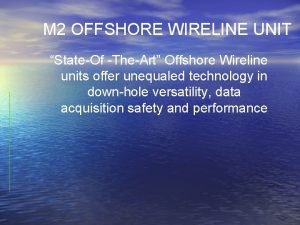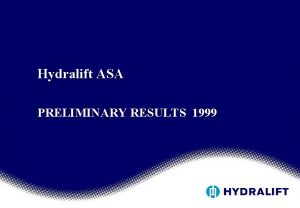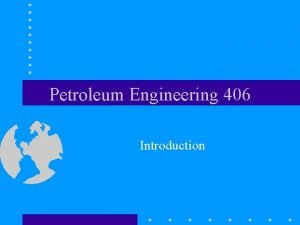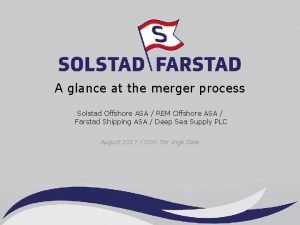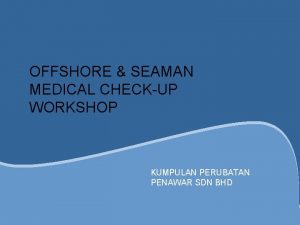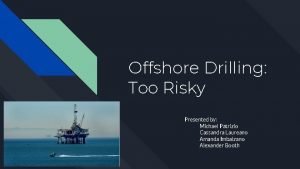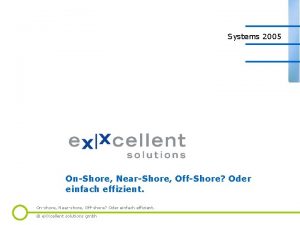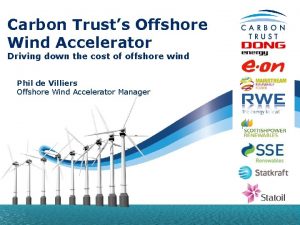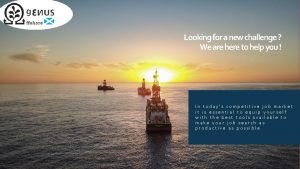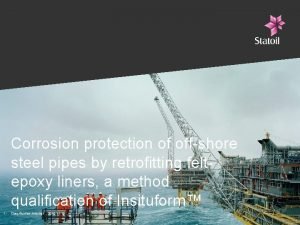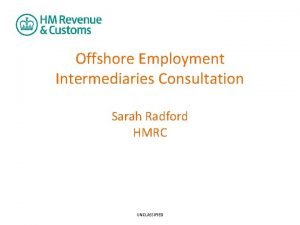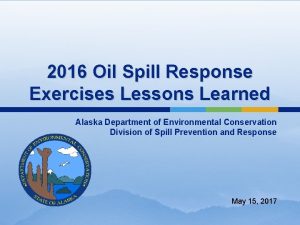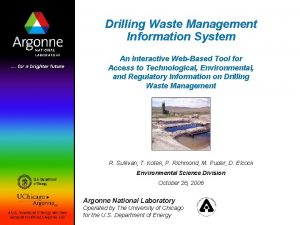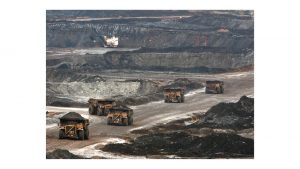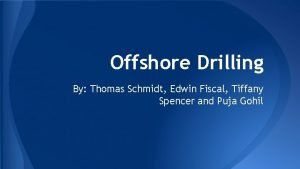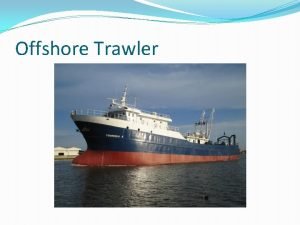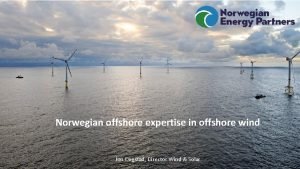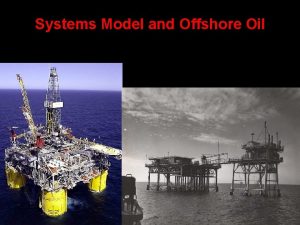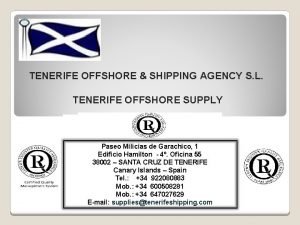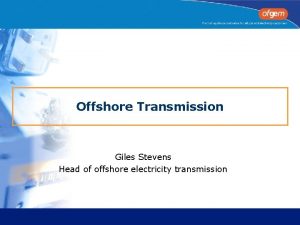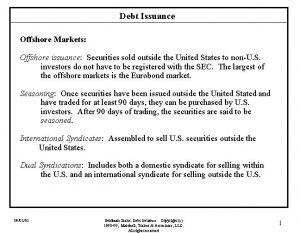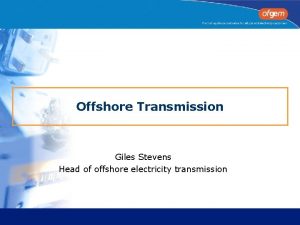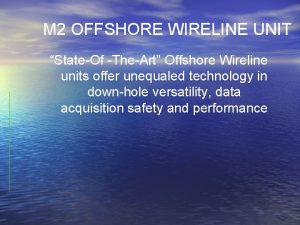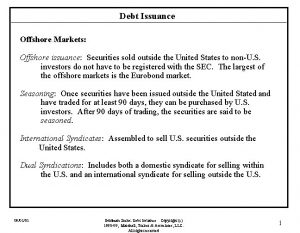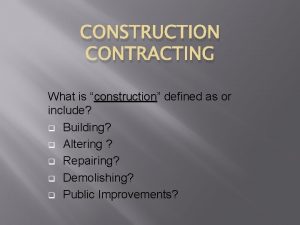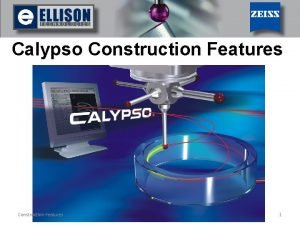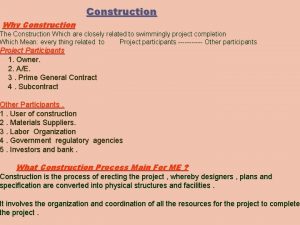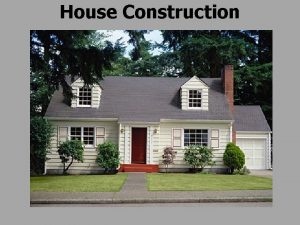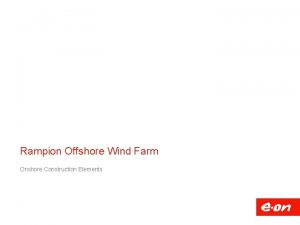OFFSHORE CONSTRUCTION WHAT IS OFFSHORE CONSTRUCTION It is


























- Slides: 26

OFFSHORE CONSTRUCTION

WHAT IS OFFSHORE CONSTRUCTION? It is the installation of structures and facilities in a marine environment, usually for the production and transmission of electricity, oil, gas and other resources.

“OFFSHORE STRUCTURES” It is also called “OFFSHORE PLATFORM/” It is used worldwide for a variety of functions and in a variety of water depths, and environments. It is huge steel or concrete structures used to explore and extract oil and natural gas, and to temporarily store product until it can be brought to shore for refining and marketing.

TYPES OF OFFSHORE CONSTRUCTION

1. JACKET - is a welded tubular space frame with three or more near vertical tubular chord legs with a bracing system between the legs. The jacket provides support for the foundation piles, conductors, risers and other appurtenances. A jacket foundation includes leg piles which are inserted through the legs and connected to the legs either at the top, by welding or mechanical means.


2. JACK-UP – comprises a floating hull and three or more legs, which can move up and down relative to the hull. It reaches its operational mode by lowering the legs to the sea floor and then raising the hull to the required elevation. The legs can be moved independently. Majority of jack-ups are built for shortterm operation at different locations around the world.


3. COMPLIANT TOWER – is a flexible structure with flex elements (principally flexible legs or axial tubes) to control mass and stiffness characteristics so as to mitigate the effects of periodic wind, wave and current forces. Compliant towers are relatively slender compared with jacket structures.


4. GRAVITY STRUCTURE – (or gravity-based structures) are fixed structures that are held in place against environmental actions solely by their weight plus that of any contained ballast, together with foundation resistance resulting from their weight and lateral resistance from any skirts.


5. MONOTOWER – is a fixed structure in which the whole structure, or at least the upper part of the structure, consists a single vertical column (tubular or framed) that carries the topsides.


6. DRILLSHIPS - is a maritime vessel that has been fitted with drilling apparatus. It is most often used for exploratory drilling of new oil or gas wells in deep water but can also be used for scientific drilling.


7. SEMI-SUBMERSIBLE PLATFORM – are platforms that can be moved from place to place and can be ballasted up or down by altering the amount of flooding in buoyancy tanks. They are generally anchored by combinations of chain, wire rope or polyester rope, or both, during drilling and/or production operations.


8. TENSION LEG PLATFORM - are floating platforms tethered to the seabed in a manner that eliminates most vertical movement of the structure. Mini TLPs can also be used as utility, satellite or early production platforms for larger deep water discoveries.


9. SPAR - are moored to the seabed like TLPs, but whereas a TLP has vertical tension tethers, a spar has more conventional mooring lines. The spar has more inherent stability than a TLP since it has a large counterweight at the bottom and does not depend on the mooring to hold it upright. It also has the ability, by adjusting the mooring line tensions to move horizontally and to position itself over wells at some distance from the main platform location.


10. NORMALLY UNMANNED INSTALLATIONS (NUI) sometimes called toadstools, are small platforms, consisting of little more than a well bay, helipad and emergency shelter. They are designed to be operated remotely under normal conditions, only to be visited occasionally for routine maintenance or well work.


11. CONDUCTOR SUPPORT SYSTEM - These installations, also known as satellite platforms, are small unmanned platforms consisting of little more than a well bay and a small process plant. They are designed to operate in conjunction with a static production platform which is connected to the platform by flow lines or by umbilical cable, or both.

 What is offshore construction
What is offshore construction Biggest offshore wind farm produces
Biggest offshore wind farm produces Offshore platform design
Offshore platform design Structural dynamics of deep water offshore wind turbines
Structural dynamics of deep water offshore wind turbines Offshore design
Offshore design Offshore wireline
Offshore wireline Hydralift offshore cranes
Hydralift offshore cranes Medical summarization outsourcing
Medical summarization outsourcing Offshore drilling
Offshore drilling National oilwell v davy offshore
National oilwell v davy offshore Iii offshore advisors
Iii offshore advisors Solstad offshore ukraine
Solstad offshore ukraine Petronas medical check up
Petronas medical check up Offshore drilling
Offshore drilling Nearshore offshore onshore
Nearshore offshore onshore Offshore wind accelerator
Offshore wind accelerator Cv looking for a new challenge
Cv looking for a new challenge Offshore pipes
Offshore pipes Offshore graphic design
Offshore graphic design K line offshore as
K line offshore as Offshore employment intermediaries
Offshore employment intermediaries Offshore drilling
Offshore drilling Tech dwmis
Tech dwmis Offshore drilling
Offshore drilling Offshore drilling
Offshore drilling Virtual employee offshore
Virtual employee offshore Offshore delivery assessment
Offshore delivery assessment


